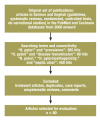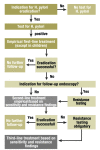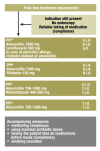Helicobacter pylori and gastroduodenal ulcer disease
- PMID: 20038978
- PMCID: PMC2797331
- DOI: 10.3238/arztebl.2009.0801
Helicobacter pylori and gastroduodenal ulcer disease
Abstract
Background: Helicobacter pylori-associated diseases and gastroduodenal ulcer disease are common conditions of major clinical and economic importance. There is thus a need for a guideline that incorporates the scientific knowledge gained in recent years and that takes specific aspects of the situation in Germany into account with regard to epidemiology, resistance status, diagnostic evaluation, and treatment.
Methods: This level-S3 consensus guideline was developed in accordance with the recommendations of the Association of Scientific Medical Societies in Germany (Arbeitsgemeinschaft der Wissenschaftlichen Medizinischen Fachgesellschaften, AWMF). It was commissioned by the German Association for Digestive and Metabolic Diseases (Deutsche Gesellschaft für Verdauungs- und Stoffwechselkrankheiten, DGVS) and prepared in cooperation with other scientific societies. After search terms were compiled, a systematic, IT-supported literature search was performed in the PubMed and Cochrane databases. The search was restricted to articles that appeared in German or English from 2000 onward.
Results: H. pylori infection can be accurately diagnosed either non-invasively (with a (13)C-urea breath test or a stool antigen test) or invasively (with a rapid urease test, by histology, or by culture). Gastric and duodenal ulcer and gastric MALT lymphoma are absolute indications for eradication therapy; relative indications include functional dyspepsia, the prevention of gastric cancer in persons at risk, the initiation of long-term treatment with non-steroidal anti-inflammatory drugs (NSAID), and the prior occurrence of gastroduodenal complications with the use of either NSAID or acetylsalicylic acid (ASA). First-line therapy consists of a proton-pump inhibitor (PPI) and clarithromycin combined with either metronidazole or amoxicillin, given for at least one week.
Conclusion: This guideline enables the structured, evidence-based diagnosis and treatment of H. pylori infection and associated conditions, as well as of gastroduodenal ulcer disease.
Keywords: Helicobacter pylori; duodenal ulcer; gastric ulcer; guideline.
Figures



Similar articles
-
S3-guideline "helicobacter pylori and gastroduodenal ulcer disease" of the German society for digestive and metabolic diseases (DGVS) in cooperation with the German society for hygiene and microbiology, society for pediatric gastroenterology and nutrition e. V., German society for rheumatology, AWMF-registration-no. 021 / 001.Z Gastroenterol. 2009 Dec;47(12):1230-63. doi: 10.1055/s-0028-1109855. Epub 2009 Dec 3. Z Gastroenterol. 2009. PMID: 19960402
-
Current concepts in the management of Helicobacter pylori infection--the Maastricht 2-2000 Consensus Report.Aliment Pharmacol Ther. 2002 Feb;16(2):167-80. doi: 10.1046/j.1365-2036.2002.01169.x. Aliment Pharmacol Ther. 2002. PMID: 11860399 Review.
-
[Short version of the S3 (level 3) guideline "Helicobacter pylori and gastroduodenal ulcer disease" from the German Society for Digestive and Metabolic Diseases].Dtsch Med Wochenschr. 2009 Sep;134(37):1830-4. doi: 10.1055/s-0029-1237521. Epub 2009 Sep 2. Dtsch Med Wochenschr. 2009. PMID: 19728254 German.
-
[Helicobacter pylori].Internist (Berl). 2009 Aug;50(8):979-86; quiz 987. doi: 10.1007/s00108-009-2438-3. Internist (Berl). 2009. PMID: 19609771 Review. German.
-
Are twelve days of omeprazole, amoxicillin and clarithromycin better than six days for treating H. pylori infection in peptic ulcer and in non-ulcer dyspepsia?Hepatogastroenterology. 2001 Sep-Oct;48(41):1383-8. Hepatogastroenterology. 2001. PMID: 11677970
Cited by
-
Gastroduodenal Changes Two Years After Eradication of Helicobacter pylori in a Population-Based Cohort.Gastroenterology Res. 2015 Apr;8(2):171-177. doi: 10.14740/gr646w. Epub 2015 Apr 3. Gastroenterology Res. 2015. PMID: 27785292 Free PMC article.
-
Ultra-deep sequencing reveals the microRNA expression pattern of the human stomach.PLoS One. 2010 Oct 8;5(10):e13205. doi: 10.1371/journal.pone.0013205. PLoS One. 2010. PMID: 20949028 Free PMC article.
-
Overview of Helicobacter pylori Infection: Clinical Features, Treatment, and Nutritional Aspects.Diseases. 2021 Sep 23;9(4):66. doi: 10.3390/diseases9040066. Diseases. 2021. PMID: 34698140 Free PMC article. Review.
-
[Aspirin desensitization: therapy options in patients with aspirin-exacerbated respiratory disease].HNO. 2012 Apr;60(4):369-83. doi: 10.1007/s00106-011-2444-3. HNO. 2012. PMID: 22491884 German.
-
The Indications, Applications, and Risks of Proton Pump Inhibitors.Dtsch Arztebl Int. 2016 Jul 11;113(27-28):477-83. doi: 10.3238/arztebl.2016.0477. Dtsch Arztebl Int. 2016. PMID: 27476707 Free PMC article. Review.
References
-
- Warren JR, Marshall BJ. Unidentified curved bacilli in the stomach of patients with gastritis and peptic ulceration. Lancet. 1984;1:1311–1315. - PubMed
-
- Fischbach W, Malfertheiner P, Hoffmann JC, et al. S3-Leitlinie „Helicobacter pylori und gastroduodenale Ulkuskrankheit“ der Deutschen Gesellschaft für Verdauungs- und Stoffwechselkrankheiten (DGVS). In Zusammenarbeit mit der Deutschen -Gesellschaft für Hygiene und Mikrobiologie, Gesellschaft für -Pädiatrische Gastroenterologie und Ernährung e.V. und der Deutschen Gesellschaft für Rheumatologie - AWMF-Register-Nr. 021/001. Z Gastroenterol. 2009;47:68–102. An English version is currently in print (Z Gastroenterol, puplication expected for December 2009) - PubMed
-
- Grimm W, Fischbach W. Helicobacter pylori infection in children and juveniles: an epidemiological study on prevalence, socio-economic factors and symptoms. Dtsch Med Wochenschr. 2003;128:1878–1883. - PubMed
-
- Brenner H, Weyermann M, Rothenbacher D. Clustering of Helicobacter pylori infection in couples: differences between high- and low-prevalence population groups. Ann Epidemiol. 2006;16:516–520. - PubMed
-
- Parsonnet J. The incidence of Helicobacter pylori infection -Aliment Pharmacol Ther. 1995;9(Suppl 2):45–51. - PubMed
Publication types
MeSH terms
LinkOut - more resources
Full Text Sources
Medical

